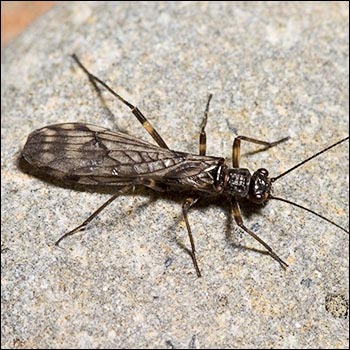ENTYMOLOGY/FLIES
For many years, I fished the Mt. Hood streams
with little more than a greased–up Royal Coachman. Don’t get me wrong, I caught
plenty of fish, but all were small, in the four to six inch range. Then, one
day I decided to try a small Pheasant tail nymph. I was pleasantly surprised by
a twelve inch fish. Wondering what I did differently, I investigated by turning
over numerous rocks in the river. I found that in the particular river I was
fishing (The Oak Grove Fork) there was an abundance of small mayfly nymphs,
belonging to Blue Winged Olives. Since then, I have always brought size 14
mayfly nymphs, as well as actual BWO’s during the late summer hatches, and have
caught many fish over 14 inches.
Keep in mind, these rivers are still easy to
fish. If you want to throw out Royal Coachmans and Humpies on 3x tippets, and
catch six inch trout, that is fine. But if you want to precisely cast 7x
tippets with size 18 Cascade Flying Ants, you will be rewarded with 14+ inch
fish. It’s your call.
Also, I am no etymologist. You should by no means use this as a reference for all forms of insect life on the Mt. Hood streams. These are just a few prominent hatches. Next spring and summer, I will make it my goal to find more groups and species of insects and include them to my blog on how to fish the Mt. Hood area.
Blue Winged Olives:

On the Oak Grove
Fork, Blue Winged Olives are the main mayfly that can be found hatching during
the summer and fall months. These Blue Winged Olives are greener than most, and
have unusually short bodies. When they hatch, the waters won’t be exploding
like with other mayflies, but the trout will clearly be going nuts, busting the
surface all around you. Good flies are obviously the BWO, in size 12’s.
Remember that even though it might look strange at first, always tie the wing
as big as you can so as to match the naturals more. The nymphs are size 14’s,
and are dark brown, so they are best imitated by Pheasant Tails in that size.
Some good patterns are below:
Blue Winged
Olive, Dry: #12
Blue Winged Olive
Emerger, #12
Bead Head
Pheasant Tail, #14
Olive Comparadun,
#12
Cased Caddis Fly:
As aforesaid, I am not an entomologist. I don’t know or care
what particular species the caddis flies that that I catch fish on are, and
neither should you. All that is important is that in many of the Mt. Hood
streams, especially the Zigzag and Salmon, small cased caddis flies are a
staple of the trout found there. They are small, ranging in a size 12 or so,
and when they hatch, the normally tricky fishing on those alpine creeks becomes
much easier.
Nymphing can also be good, for reasons I will never understand. Of all the crazy and disgusting crawly things trout eat, I can at least understand the motivation with some of the mayflies and stoneflies. However, the attraction trout have to cased caddis nymphs is strange to say the least. These insects are usually, if not always, covered with a shell of gravel, dirt, silt, mud, or plant life. Why a trout would want that in its stomach is beyond me.
Despite this, caddis flies become the main food source for the trout in these creeks.
Even during the spring time, these patterns make great attractor flies, and are
very productive. Some good ones are below:
Elk Hair Caddis, Gray, Orange, Brown, #10-14
X-wing Caddis, Gray, Orange, Brown, #10-14
Goddard Caddis with spun deer hair body, Gray,
Orange, Brown, #10-14
Cased Caddis with pebbles from river glued to
body, #10-12
Spun Rubber Cased Caddis, #12
Black Stonefly:

Yes, there are
giant stoneflies here! Once again, I’m pretty lost on the species in
particular, although the Tiny Winter Black might be an option. Regardless,
although the sheer number that hatch come nowhere near to rivaling that of the
Deschutes River forty minutes away, they still can provide great fishing for
some of the bigger trout that don’t fall for as much as the smaller, uneducated
fish. The nymphs are also very effective, as long as they are fished deep. No
stonefly is going to be caught dead in the middle of the water column.
Black Stimulator,
#4
Black Bullethead
Stonefly, #4
Kaufmann’s
Stonefly Nymph, #4
Terrestrials:
Extremely effective on the creeks during the late
spring and summer months, terrestrials imitate beetles, grasshoppers, and a
host of other land-dwelling insects that have been blown into the water due to
wind. All are best fished dead
drift. Some caddis patterns can be used
to mimic terrestrials because of their resemblance to grasshoppers. Still, in
my opinion, the all-around best terrestrial to use on these creeks is a size 14
black foam beetle.
Before tying a terrestrial to your tippet, always
take time to observe the local insect populations. Trout primarily subsist on aquatic insects
and only feed on the occasional terrestrial that drifts by. Tying on a terrestrial pattern is not likely
to be productive in the midst of a busy BWO hatch where fish will be focused on
emerging aquatic insects. I used to
think of terrestrials as "last resort" patterns, but now I consider
them a good addition to your arsenal when going after the big trout when there
are no hatches.
Cascade Flying Ant, # 14-18
Black Beetle, #12-14
Deer Hair Hopper, #8-14
Inchworm, #18
No comments:
Post a Comment